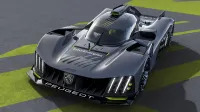Dodge could enter Peugeot’s Le Mans-bound 9×8 hypercar in IMSA races

Fiat-Chrysler Automobiles (FCA) and PSA Group merged under the Stellantis umbrella in early 2021 to achieve economies of scale, and this benefit could surprisingly extend to racing. Executives are debating whether to give Dodge its own version of Peugeot’s recently-unveiled 9×8 hypercar to race in America, according to a recent report.
“While we only heard [the new rules] confirmed a week ago, it has certainly led to some very open discussion, not only about whether Peugeot might add races in the United States, but also about whether the spine of this car might have opportunities with other brands in the Stellantis Group. There are no conclusions yet, but there are now open discussions,” affirmed Jean-Marc Finot, the Senior Vice President of Stellantis, in an interview with Racer.
His comments refer to an agreement signed in July 2021 by the Automobile Club de l’Ouest (ACO), the Fédération Internationale de l’Automobile (FIA), and the International Motor Sports Association (IMSA). They chose to align their technical regulations to let manufacturers compete in different events on both sides of the pond without going through the resource-consuming process of developing a specific car for each series. As of writing, the Le Mans Hypercar (LMH) and Le Mans Daytona h (LMDh) categories fall under the newly-announced common set of rules.
On the surface, this means Peugeot could enter its 9X8 (pictured) in the WeatherTech SportsCar Championship as soon as the 2023 season. While this is seemingly under consideration, Peugeot has little to gain from winning a major race in the United States. It hasn’t sold cars here since 1991, and its long-mooted comeback was canned after PSA merged with FCA. Giving a variant of the 9X8 to Dodge is a more credible possibility, according to Racer.
If not Dodge, then who else? Chrysler hasn’t been linked to racing or performance for decades. Jeep is no stranger to performance vehicles, but IMSA would be pushing it. Ram is Ram, while Fiat, Alfa Romeo, and Maserati are rooted in Europe. The rest of the Stellantis brands (like Opel, Lancia, and Citroën) are not distributed in America.
Nothing is official, and the publication stressed it’s unclear whether Dodge will commit part- or full-time to the series (assuming the program receives the green light). Finot underlined the parallel car would use the 9X8’s “spine,” so don’t expect to see a Peugeot hypercar with a Dodge emblem driving flat-out on the Sebring International Raceway. Odds are the model would wear a brand-specific exterior design. It’s what’s under the body that will carry over.
The underpinnings (shown above) are promising, regardless of whether they compete in Europe or in the United States. Power for the 9X8 comes from a gasoline-electric hybrid powertrain built around a twin-turbocharged, 2.6-liter V6 that sends 670 horsepower to the rear wheels via a seven-speed sequential transmission. The electric part of the system is a 268-horsepower motor that zaps the front wheels into motion by drawing electricity from a 900-volt battery pack. The combined output is restricted to 670 horsepower, so the electric motor can come into play anytime the engine isn’t making peak horsepower, particularly at lower rpm.
There’s no word yet on when Stellantis will decide whether to give Dodge (or another firm) the 9X8’s blueprints to play with. In the meantime, Peugeot will put the final touches on the car to prepare it for its racing debut in 2022.
“We will race when we have both the performance and reliability that we want to have [and] confidence in finalizing the homologation. After that, we will have the homologation locked in for several years, so it is important to present the very best car we can before taking that step,” he explained. Peugeot will also build at least 20 road-legal cars.
Related Video:
.embed-container { position: relative; padding-bottom: 56.25%; height: 0; overflow: hidden; max-width: 100%; } .embed-container iframe, .embed-container object, .embed-container embed { position: absolute; top: 0; left: 0; width: 100%; height: 100%; }




